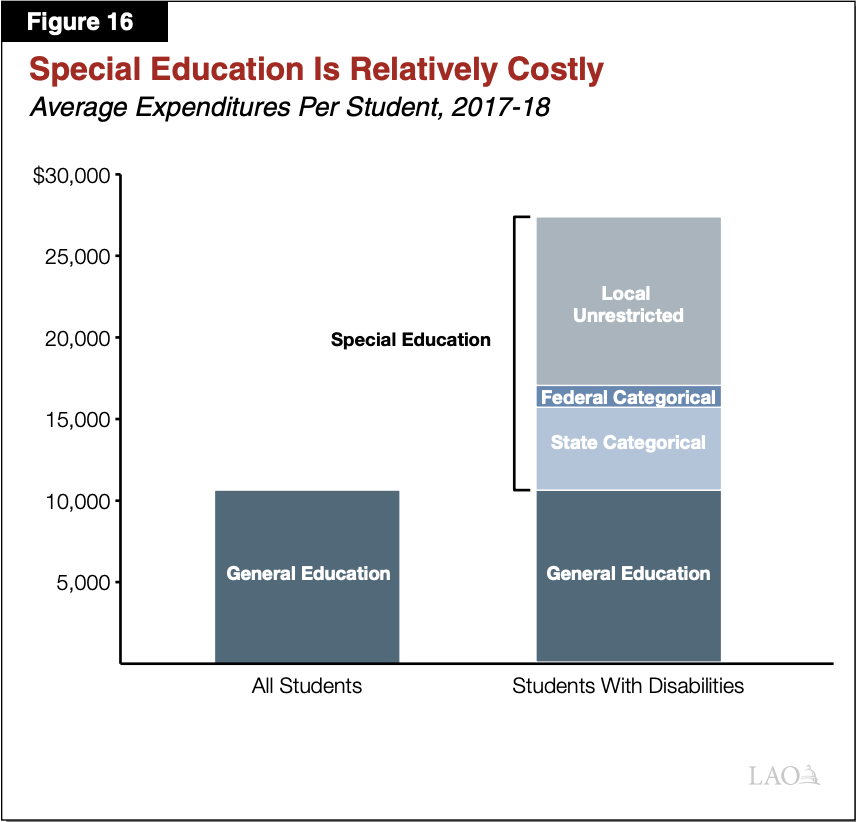Special Education Costs Flood School Budgets

Districts Struggle to Stay Afloat
The rising costs of special education services are overwhelming your school district budget. And we are talking big bucks. Nearly 800,000 students in California receive special education services — about one in every eight students.
According to 2019 estimates by the California Legislative Analyst Office (LAO), the average annual cost of educating a student with disabilities — $27,000 — is almost triple the cost to educate a student without disabilities — about $10,000.
Special education is funded by a combination of federal, state and local dollars, as described in the chart below. The federal portion is the smallest part: in the chart, it's represented by that small sliver of blue.

To qualify for these federal funds, California commits some state funds, shown on the chart as "state categorical." Notice, however, that the largest portion of the funds for special education services come from local district budgets — called “Local Unrestricted” on the chart. These costs are primarily paid out of your district LCFF funds, reducing funding for other services.
How does this work? Why are school districts — not the state and the federal government — footing most of the costs? Why are costs going up? Here’s what you need to know.
Federal Goals Unmatched by Federal Funds
Before the 1970s, many schools did not educate children with disabilities. Court cases and changes in public opinion led to change: in 1975 Congress enacted a bipartisan civil rights law later named the Individuals with Disabilities Education Act (IDEA). This federal law, last renewed in 2004, requires that special education services be individually provided for each child with disabilities.
The Target: 40%
Educating children with disabilities costs more than educating children without them. From the start, a combination of federal funding and dedicated state funding was part of the plan. The law set a target: for each student identified, federal funds would cover up to 40 percent of the additional costs.
Federal funding for special education has never come close to this 40 per cent target, which is commonly called “Full Funding.” (A lot of folks are confused by this term. I know I was. It just means meeting the federal 40 per cent target for funding, not funding ALL special education costs.)
The Reality: 15%
Just how much is the federal government short-changing the states? According to the California Legislative Analyst, “Actual federal funding to California schools has long fallen short of this target. It was $3.2 billion below the target in 2018-19.” The current national level of funding is just under 15 per cent, far below the 40 percent target.
State and District Funds Pay for Most Special Education Services
Though far less than promised, federal dollars for special education services still matter. IDEA has been reauthorized and modified several times, most recently in 2014.
To access federal IDEA funds, California dedicates funds for special education as part of the state's general fund budget. (It's counted as part of the Proposition 98 budget.)
In California, most of the state and federal funding designated for special education is disbursed to school districts and charter schools through a system of Special Education Local Plan Areas (SELPAs). These entities coordinate special education services within a geographic region or a group of school districts.
As with overall federal and state funding for special education, money is allocated to SELPAs on the basis of overall attendance in order to avoid creating an incentive to identify lots of students as disabled.
This approach has been a subject of debate because some school districts have higher costs and higher numbers of students with disabilities. An important study associated with Getting Down to Facts concluded that this system avoids creating financial incentives to over-identify and inappropriately place students in special education programs. (This is a particular concern for minority students.)
Governor Newsom, who struggled with dyslexia as a child, has indicated that he intends to make a priority of improving the state's funding systems for special education.
A Zero-sum Problem
Districts and charter schools must meet the needs of each student who qualifies for special education services. It's the law, regardless of whether sufficient federal and state funds have been specifically set aside for it.
The cost of providing special education services has risen significantly over time. Neither federal nor state funding has kept pace. The math is unavoidably zero-sum.
To pay for special education services, school districts and charter schools use unrestricted funds from LCFF, which reduces the amount of money available for other students and programs. The portion of the cost of special education that is locally funded has grown from 49 percent of the cost in 2007-08 to 61 percent in 2017-18.
Special Education Costs Are Up. How Much? Why?
Autism rates are rising
The cost of providing special education services in California has grown significantly over time. In 2017-18 the total cost was about $13 billion. According to the state Legislative Analyst Office this represented an increase of about 28 percent over a decade earlier, adjusted for inflation. The percentage of students receiving special education services jumped from 11 percent to 13 percent.
What happened? About two-thirds of the cost increases reflect the growing number of students with severe disabilities, especially autism. According to the Legislative Analyst Report LAO School District Funding 2020, “The share of students identified with autism has increased from 1 in 600 students in 1997-98 to about 1 in 50 students in 2018-19. Many medical experts expect autism rates to continue increasing, thereby placing continued cost pressure on schools.”
Quick Recap
- Federal law requires states to provide special education services, but federal funding does not cover the costs at the intended level.
- The state allocates categorical funds — dedicated money — to pay for special education services, but not at a level that matches growing costs.
- School districts and charter schools are legally required to educate all students, including those who need special education services. As the cost of educating students with autism has risen, school districts have picked up most of the cost.
|
Dig Deeper |
|---|
|
Read the Overview of Special Education in California 2019 from the California Legislative Analyst |
|
Read the Governor’s Proposed Education Budget 2020-21. Read pages starting at 77 for a discussion of his funding proposals. |
|
Read The Individuals with Disabilities Education Act (IDEA) Funding: A Primer from the Congressional Research Service. |
|
Read the argument for IDEA Full Funding from the National Center for Learning Disabilities |
|
Read Revisiting Finance and Governance Issues in Special Education from the Getting Down to Facts project |
|
Read The Next Big Thing: Fix Special Education from the Ed100 blog |
Tags on this post
All Tags
A-G requirements Absences Accountability Accreditation Achievement gap Administrators After school Algebra API Arts Assessment At-risk students Attendance Beacon links Bilingual education Bonds Brain Brown Act Budgets Bullying Burbank Business Career Carol Dweck Categorical funds Catholic schools Certification CHAMP Change Character Education Chart Charter schools Civics Class size CMOs Collective bargaining College Common core Community schools Contest Continuous Improvement Cost of education Counselors Creativity Crossword CSBA CTA Dashboard Data Dialogue District boundaries Districts Diversity Drawing DREAM Act Dyslexia EACH Early childhood Economic growth EdPrezi EdSource EdTech Education foundations Effort Election English learners Equity ESSA Ethnic studies Ethnic studies Evaluation rubric Expanded Learning Facilities Fake News Federal Federal policy Funding Gifted Graduation rates Grit Health Help Wanted History Home schools Homeless students Homework Hours of opportunity Humanities Independence Day Indignation Infrastructure Initiatives International Jargon Khan Academy Kindergarten LCAP LCFF Leaderboard Leadership Learning Litigation Lobbyists Local control Local funding Local governance Lottery Magnet schools Map Math Media Mental Health Mindfulness Mindset Myth Myths NAEP National comparisons NCLB Nutrition Pandemic Parcel taxes Parent Engagement Parent Leader Guide Parents peanut butter Pedagogy Pensions personalized Philanthropy PISA Planning Policy Politics population Poverty Preschool Prezi Private schools Prize Project-based learning Prop 13 Prop 98 Property taxes PTA Purpose of education puzzle Quality Race Rating Schools Reading Recruiting teachers Reform Religious education Religious schools Research Retaining teachers Rigor School board School choice School Climate School Closures Science Serrano vs Priest Sex Ed Site Map Sleep Social-emotional learning Song Special ed Spending SPSA Standards Strike STRS Student motivation Student voice Success Suicide Summer Superintendent Suspensions Talent Teacher pay Teacher shortage Teachers Technology Technology in education Template Test scores Tests Time in school Time on task Trump Undocumented Unions Universal education Vaccination Values Vaping Video Volunteering Volunteers Vote Vouchers Winners Year in ReviewSharing is caring!
Password Reset
Search all lesson and blog content here.
Login with Email
We will send your Login Link to your email
address. Click on the link and you will be
logged into Ed100. No more passwords to
remember!
















Questions & Comments
To comment or reply, please sign in .
Brenda Etterbeek March 10, 2020 at 11:48 am
Jeff Camp March 26, 2020 at 11:59 am
Brenda Etterbeek February 18, 2020 at 12:54 pm